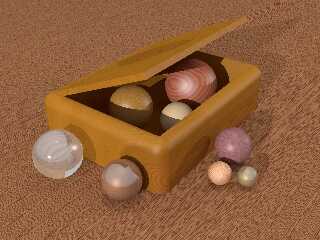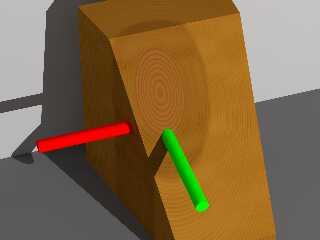 |
 |
|
 |
|
 |
|  |
|  |
|
 |
|
 |
|  |
|  |
|
 |
"Mr" <m******r******at_hotmail_dot_fr> wrote:
>
> This is entering crazy good level realm ! :-)
Thank you.
Thomas de Groot <tho### [at] degroot org> wrote:
> Op 26/05/2022 om 13:42 schreef And:
> > Modify it with rather casual, I need 2-3 weeks to arrange the output .inc files.
> >
> > The knot is an experimental feature.
> > In fact, I'm not clear on how these knot pattern form in photographs.
> >
> Well, as knots are cross-sections of branches at different angles, you
> can consider them identical to the main cross-section of the trunk wood.
> Your attempt is very convincing, although - I suppose - your approach to
> generate them is different.
>
> --
> Thomas
Different approach...maybe. Totally the concept, it is about... I draw the
standard concentric circles(internal wood pattern) there, but I change the input
coordinate (x, y, z) to (x/factor(..), y/factor(..), z), than it distortion the
original space on x-y plane direction.
The knot is the same. I distortion the pattern shape in a narrow range, (vs r
theta and z) org> wrote:
> Op 26/05/2022 om 13:42 schreef And:
> > Modify it with rather casual, I need 2-3 weeks to arrange the output .inc files.
> >
> > The knot is an experimental feature.
> > In fact, I'm not clear on how these knot pattern form in photographs.
> >
> Well, as knots are cross-sections of branches at different angles, you
> can consider them identical to the main cross-section of the trunk wood.
> Your attempt is very convincing, although - I suppose - your approach to
> generate them is different.
>
> --
> Thomas
Different approach...maybe. Totally the concept, it is about... I draw the
standard concentric circles(internal wood pattern) there, but I change the input
coordinate (x, y, z) to (x/factor(..), y/factor(..), z), than it distortion the
original space on x-y plane direction.
The knot is the same. I distortion the pattern shape in a narrow range, (vs r
theta and z)
Post a reply to this message
|
 |
|  |
|  |
|
 |
|
 |
|  |
|  |
|
 |
"And" <49341109@ntnu.edu.tw> wrote:
> Different approach...maybe. Totally the concept, it is about... I draw the
> standard concentric circles(internal wood pattern) there, but I change the input
> coordinate (x, y, z) to (x/factor(..), y/factor(..), z), than it distortion the
> original space on x-y plane direction.
>
> The knot is the same. I distortion the pattern shape in a narrow range, (vs r
> theta and z)
#declare knot_theta_pos = 0.24*pi;
#declare knot_range = 0.41*pi; // 0.28*pi
#declare knot_h_pos = 1.36;
// simple temp r, not a formal one
#declare f_r_vs_t =
function(var_t, h) {
0.03* var_t
}
// r_of_it means the distant of p to the knot(stem) center line.
// but only approximate.
#declare f_knot_about =
function(var_t, r_of_it) {
select(
r_of_it - knot_range/2,
(f_r_vs_t(var_t, 0) +0.001*(cos(r_of_it*2*pi/knot_range) +
1)/2/pow(abs(r_of_it), 1.5) )/f_r_vs_t(var_t, 0),
1
)
}
#declare f_knot =
function(x, y, z) {
f_knot_about(time_mockup_function(x, y, z), sqrt(pow(f_theta(x,y) -
knot_theta_pos, 2) + pow((z - knot_h_pos)/f_r(x, y, z), 2)) )
}
// -----------------------------------------
#declare time_mockup_with_knot_function =
function (x, y ,z){
time_mockup_function(
x/f_knot(x, y, z),
y/f_knot(x, y, z),
z
)
}
Post a reply to this message
|
 |
|  |
|  |
|
 |
|
 |
|  |
|  |
|
 |
"jr" <cre### [at] gmail com> wrote:
> hi,
>
> "And" <49341109@ntnu.edu.tw> wrote:
> > ...
> > Now I know it does not finish yet.
>
> do you always do "blocks", or have you put the texture to use yet? (thinking,
> eg, the distribution 'woodbox.pov' scene, or such)
>
>
> regards, jr.
After investigate colors from photo. put them together reluctantly.
I apply this yellow color wood to woodbox.pov, only the container. com> wrote:
> hi,
>
> "And" <49341109@ntnu.edu.tw> wrote:
> > ...
> > Now I know it does not finish yet.
>
> do you always do "blocks", or have you put the texture to use yet? (thinking,
> eg, the distribution 'woodbox.pov' scene, or such)
>
>
> regards, jr.
After investigate colors from photo. put them together reluctantly.
I apply this yellow color wood to woodbox.pov, only the container.
Post a reply to this message
Attachments:
Download 'woodbox test.png' (3516 KB)
Preview of image 'woodbox test.png'

|
 |
|  |
|  |
|
 |
|
 |
|  |
|  |
|
 |
Today I searched some procedural wood texture generator on the web, I never got
( maybe I did not concentrate enough) such a program before.
I found two this time.
https://www.blendernation.com/2019/08/08/timber-a-realistic-procedural-pbr-wood-material/
https://blendermarket.com/products/carvature
At the beginning of design my program, I choosed a simple and feasible compage
for it. After adjusting the result texture attentively, I found it can also
accomplish the level. That tempted me to put it into a commercial, too. But
developing software is such a huge affair, I know I will release it in the form
of freeware( maybe alpha or beta test version) before it have the basic
quality(like open/save, or select colors in the gui program).
I'm looking forward PayPal (for the 3D models selling), it will be a new
experience for me at least.
Before release the program, I must learn to prepare something first, and learn
to compile it.
Post a reply to this message
|
 |
|  |
|  |
|
 |
|
 |
|  |
|  |
|
 |
hi,
"And" <49341109@ntnu.edu.tw> wrote:
> ...
> After investigate colors from photo. put them together reluctantly.
glad you did. the pattern looks sumptuous, in particular I'm impressed by just
how believable the texture looks, the graining on the narrow side of the lid is
... wow.
regards, jr.
Post a reply to this message
|
 |
|  |
|  |
|
 |
|
 |
|  |
|  |
|
 |
"jr" <cre### [at] gmail com> wrote:
> hi,
>
> "And" <49341109@ntnu.edu.tw> wrote:
> > ...
> > After investigate colors from photo. put them together reluctantly.
>
> glad you did. the pattern looks sumptuous, in particular I'm impressed by just
> how believable the texture looks, the graining on the narrow side of the lid is
> ... wow.
>
>
> regards, jr.
Thank you.
I like this admix, too. com> wrote:
> hi,
>
> "And" <49341109@ntnu.edu.tw> wrote:
> > ...
> > After investigate colors from photo. put them together reluctantly.
>
> glad you did. the pattern looks sumptuous, in particular I'm impressed by just
> how believable the texture looks, the graining on the narrow side of the lid is
> ... wow.
>
>
> regards, jr.
Thank you.
I like this admix, too.
Post a reply to this message
|
 |
|  |
|  |
|
 |
|
 |
|  |
|  |
|
 |
"And" <49341109@ntnu.edu.tw> wrote:
> Thank you.
> I like this admix, too.
I imitate that box color and direct of pattern by this one (But the color is
selected by photos of mine) which the texture is scanned.
https://www.turbosquid.com/3d-models/scanned-objects-3d-model-1694388
There are too many details to imitate, but the color changing at the corner is
catch my eye. I know that proximity pattern discussed in the newsgroups.
http://news.povray.org/povray.binaries.images/thread/%3Cweb.4bda394e8fe449e421619a220%40news.povray.org%3E/
Post a reply to this message
|
 |
|  |
|  |
|
 |
|
 |
|  |
|  |
|
 |
I have completed most of the arrangement of output .inc files.
All effects remains the previous.
In fact, I doubt about the albedo of the (selected) color.
1). I knows that the albedo of many substances are between 0.0.. ~ 0.6...(60%),
the white wall or white paper is just about 60%. The correct value of the albedo
cannot measure from the photograph directly, unless you know the light source
strength.
2). The rendered image shows the current composite of patterns. Include the
fiber and big color block. It takes 20m46s to render.
3). I have fixed and eliminated the discontinuous line on the angle terminal
position.
4). The variance of the pattern is not enough for the z(height) direct. If you
cut this pattern using a cylinder, or just the "rotary peeled" method. The
result pattern will very unnatural.
Post a reply to this message
Attachments:
Download 'show tree function.png' (1013 KB)
Preview of image 'show tree function.png'

|
 |
|  |
|  |
|
 |
|
 |
|  |
|  |
|
 |
I will release a test version on the following day.
(.jar) Executable jar file
I will describe its limit.
Post a reply to this message
|
 |
|  |
|  |
|
 |
|
 |
|  |
|  |
|
 |
"And" <49341109@ntnu.edu.tw> wrote:
I didn't read this paper (yet), but it just showed up in my email inbox.
Maybe it will inspire some ideas, serve as an entry to other similar research
papers, and be of some practical use in developing your challenging project.
(I hadn't thought of using L-systems!)
-BW
https://www.academia.edu/keypass/TklERytmOFYyc2ZaWDhzZ2lKd1p2RzlPdVR5SFQ3OC9wZVB0NzAvOFI2bz0tLUdSbDRQT1R4dFpCVEFBV1lRWm
Naamc9PQ==--4e10a79e4ba8dd769635ce68308bdbcc2e9e8f3f/t/jZTSw-QwzUMmQ-CC8f8/resource/work/23491795/3Gmap_L_systems_an_ap
plication_to_the_modelling_of_wood?email_work_card=view-paper&li=0
Post a reply to this message
|
 |
|  |
|  |
|
 |
|
 |
|  |
|
 |




![]()